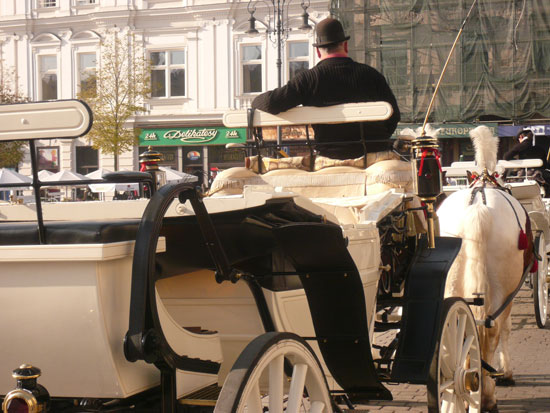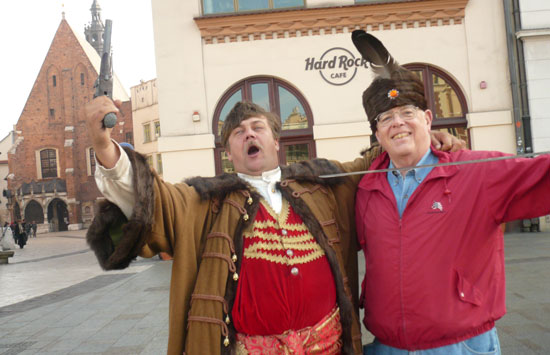

The seconds tick by until the massive tower clock of St. Mary’s Basilica in Krakow’s Old Town Square (the Rynek Glowny) strikes twelve. A bugler appears in the tower window. For ten seconds, he blows his best before abruptly stopping.
Legend has it that his predecessor in the 14th century was warning Krakow of an approaching enemy when an arrow slammed into his neck. Today, the bugler waves and disappears before repeating his performance in another direction. Twelve local firemen on 24-hour shifts perform this civic duty.
The Krakow Old Town Square is the pulse of this Polish city. Fascinated, we watch as a self-appointed citizen who calls himself, Pawl Jan (Paul John), appears next on the scene, dressed in a Magyar/Tartar uniform. His heavy fur hat and gold-buttoned red velvet vest (plus matching culottes) are topped off by a long fur coat.
A three-foot long curved sword along with a pistol accessorizes his outfit. Naturally a flowing moustache covers his face (Pawl Jan has a counterpart in Warsaw’s Old Town Square named Wario).
Pawl Jan positions his sword under my husband Kent’s chin. Click, click click He is soon joined by Lajkonik, also wearing a red velvet long robe, except that he has added other devices to make it look like he is riding a horse. (His own legs are the horse’s hind legs) More camera clicks and a few more zlotys go into the pot.
In the 14th century, Krakow had two sets of city walls plus a moat ringing the city. There was so much pillaging and plundering that all the fortifications were rendered useless. Besides the moat had a terrible smell.
At the beginning of the 19th century, Krakow’s Senate decided they had had enough. They pulled the walls down, got rid of the moat and planted a park around Krakow.

The main function of the town square in the Middle Ages was commerce. After the city was destroyed by the Mongol invasion in 1241, the main square was rebuilt in 1257.
Unlike Warsaw, Krakow was not destroyed during World War II as the Nazis had headquarters there. Today, Krakow’s Old Town Square looks much the same as it did in the 13th century.
Amidst the yellow umbrellas and tables, the venders on the square are holding court. A young man pops up in front of us and hands us a list of his restaurant specials for the day. If it is a chilly day, no problem, the heat lamps are turned on.
Even though it is late fall, outdoor eating is in full swing. When the temperature really drop, blankets are brought out. Alas, a little Americanism has crept in with the appearance of Hard Rock Cafe and Subway.
After ordering bowls of cabbage soup (with sausage) Kent and I settle ourselves under a heat lamp to take in the square. We watch as nuns in habits round the corner, while across the square a line of buggies and horses patiently waiting for fares. Their drivers peruse the daily newspaper.

School children, wearing neon vests, file by led by their teacher. The pretzel and cotton candy sellers are doing a brisk business with pigeons busy picking up crumbs on the cobblestones. Outdoor art exhibits add to the flavor, along with impromptu musicians.
It’s hard to miss the arched Cloth Hall (Sukiennice); it takes up one side of the town square. This 14th-century, two-storied structure is a bonanza for souvenirs, from handmade Polish crafts to stalls of flowers. The Gallery of 19th-Century Polish Paintings is an interesting find on the upper floor. If you get tired, another café is right outside.
The bookshops here feature mostly books in Polish, even the latest American bestsellers. Poland as a whole has a noticeable absence of signs printed in any other language besides Polish.
Eventually, it’s time for a short venture off the square onto one of the many cobblestoned streets. Pope John Paul had lived just around the corner. Three policemen were standing chatting on the sidewalk. I ask if I can take their picture.
“No FOTO!” they say. Very unusual. A lady in McDonalds had also refused my request to photograph the McDonalds menu(in Polish) above the cashier area. Could this be a throwback to the Communist era, I wondered? After all, it’s only been twenty some years.
Falling leaves have piled up and city crews are out vacuuming them up. I’m surprised at the absence of American cars here in Krakow. I counted only five; they were all Fords. Rounding out the group were Skodas, (a Czech car) Toyotas and Renaults.
We make our way two blocks over to 16 Kanonicza, the residence of Pope John Paul. Above the door is a giant photograph of the Pontiff. Here, he would often lean out the window to talk wish passers-by. Inside there’s a massive courtyard with a statue of the Pope in the center. A photograph gallery of his life circumvents the courtyard.
We venture back to the Old Town Square to have dinner at a delightful restaurant, the Wesele (the wedding) It reminds us of an old country inn. The prices are moderate for a restaurant on the Square. I enjoy zurek (sour rye soup) followed by goulash in a bread bowl. It is superb and the perfect way to end a perfect day in Krakow, Poland.
- How to Renew a US Passport Quickly and Affordably - April 19, 2024
- 6 Reasons to Visit Portland, Maine (+ Travel Tips) - April 18, 2024
- Cruising with Discovery Princess on the Mexican Riviera - March 30, 2024
